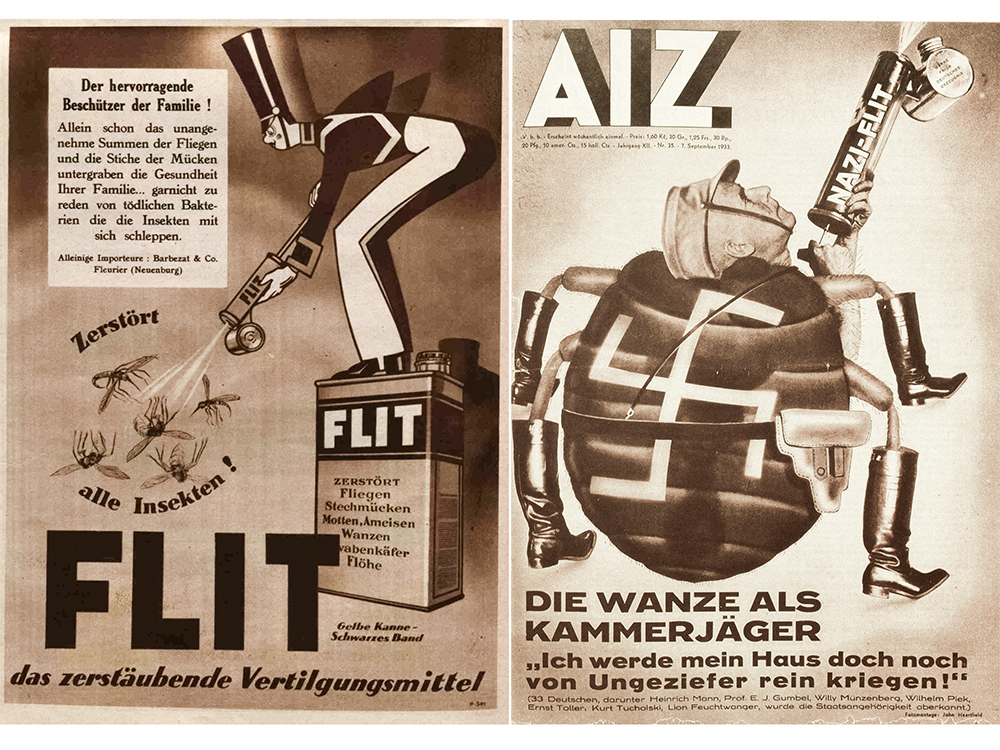Montages at the boundary between art and politics.
Text: Ylenia Sartorel
German artist John Heartfield used photomontages to shine a critical light on social issues in interwar Germany. Now, an art historian in Basel has re-examined his work.
During the interwar period, the artist John Heartfield (1891–1968) created numerous political photomontages that were regularly printed in popular illustrated magazines such as the widely circulated Arbeiter-Illustrierte-Zeitung (AIZ). To this day, one of his most well-known works remains The meaning of the Hitler salute, in which the Führer is shown reaching up as if to accept money from an oversized man standing behind him.
Under the magnifying glass
Heartfield’s photomontages, which have in the past been studied mainly from the perspective of art history and aesthetics, recently became the subject of an interdisciplinary examination by art historian and sociologist Vera Chiquet. Her lines of inquiry ranged from the role of Heartfield’s work in society to the techniques used in his creations. Besides her sociological interest, Chiquet’s expertise as an art historian stood her in good stead for the project: using a special lamp and a magnifying class, she scoured the AIZ originals for clues as to how they were made.
Heartfield, who was forced to flee Nazi Germany in 1933, and lived in the GDR from 1950 onwards, is regarded as the inventor of political photomontage. His sensitivity as an artist led him to pay close attention to the events unfolding around him – and use them in his work. In this way, he made an important contribution to the use of image manipulation to stimulate reflection. “Despite the harrowing times he was living in, he did all this with humor, gallows humor – it was his way of coping with the tribulations of the interwar years,” the researcher explains.
A reaction to propaganda
Two crucial aspects on which Heartfield’s work depended were the ease with which it could be reproduced, and the widespread dissemination of photography – a key feature of contemporary media at that time. In the years leading up to 1939, photography and painting were intimately connected as visual mediums, Chiquet explains. Photographs were rarely published in their original form – as a rule, they were enhanced manually first: advertising photography, for instance, went through an extensive retouching process.
Heartfield borrowed this technique from the field of advertising in his own work, but he always did so with critical intent. According to Chiquet, his photomontages and collages should be interpreted as a reaction to the propaganda of the European dictatorships of the time – the fascist regime in Italy in particular made frequent use of photomontages in which certain themes were depicted in a highly exaggerated manner.
The number of discrete elements that make up Heartfield’s images is not necessarily apparent at first glance – the individual photographs seem to blend into each other. It is only when looking at the resulting ensemble that viewers realize that they are in fact looking at a montage. “Heartfield’s intention was never to deceive anyone – he wanted to encourage his audience to reflect on how it consumed media, and critically examine this process,” says Chiquet. The aim of his photomontages was precisely to highlight the technique’s potential for deception. To make this abundantly clear, his images were always accompanied by the subtitle: “Photomontage: John Heartfield”.
The aesthetics of advertising
Advertising as a link between art and the mass media: The technique of drawing the viewer’s attention first and foremost to the image is a key feature of advertising – both then and now. This process of capturing and retaining viewers’ attention was described as a “clever trap” by the German philosopher Walter Benjamin. “The deceptiveness of first appearances is something that Heartfield’s work has in common with advertising – except that Heartfield’s goal was to expose the deceit of billboards and propaganda, and the intentions behind them,” says Chiquet.
The particular aesthetics of Heartfield’s montages never arose from a desire to create intricate works of art, but rather to appeal to a broad readership. “His creations are by no means complex collages that require a great deal of effort to absorb – much of the content is accessible at a glance,” Chiquet explains.
Chiquet’s research focuses primarily on Heartfield’s publications in one of Germany’s most widely read popular magazines of the time. The AIZ, run by communist publisher and editor Willi Munzenberg, was published from 1921 to 1933 in Berlin, and from 1933 to 1938 in exile in Prague. In its time, it was viewed as a groundbreaking publication for its extensive use of images and pictorial narratives. The magazine’s popularity can be attributed in large measure to Heartfield, with numerous readers cutting out his illustrations to hang as posters.
Fake news in the interwar years
“I am fascinated by the extraordinary degree to which different areas – politics, everyday life, advertising, art, technology – were intertwined in the mass media of this period,” says Chiquet, currently a researcher at the University of Basel’s Digital Humanities Lab. Heartfield’s images do not just deal with political issues – they also incorporate contemporary advertising culture and (photography) techniques, she explains. To interpret his creations, the knowledge that they are montages is crucial.
Even if a particular image as a whole does not reflect reality, the elements that comprise it do. Their place in the collage gives them a new context, subverting their original significance. This shows that the phenomenon of fake news was already an issue in interwar Germany and elsewhere: fabricated stories were disseminated by recourse to calculated manipulation in pursuit of a given (political) aim – just like today.
More articles in the current issue of UNI NOVA.

